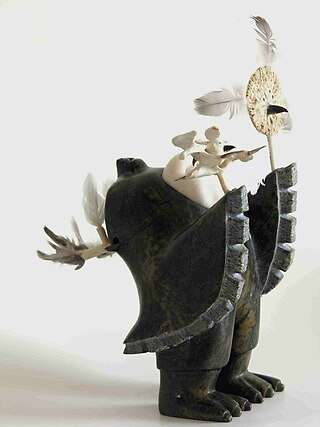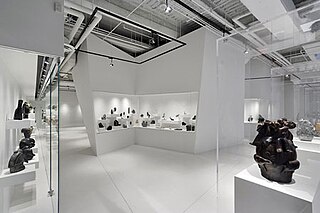Related Research Articles

The Kivalliq Region is an administrative region of Nunavut, Canada. It consists of the portion of the mainland to the west of Hudson Bay together with Southampton Island and Coats Island. The regional centre is Rankin Inlet. The population was 11,045 in the 2021 Canadian census, an increase of 6.1% from the 2016 census.

Arviat is a predominantly Inuit hamlet located on the western shore of Hudson Bay in the Kivalliq Region of Nunavut, Canada. Arviat is derived from the Inuktitut word arviq meaning "Bowhead whale". Earlier in history, its name was Tikirajualaaq, and Ittaliurvik.

Kenojuak Ashevak, was a Canadian Inuk artist. She was born on October 3, 1927 at Camp Kerrasak on southern Baffin Island, and died on January 8, 2013 in Cape Dorset, Nunavut. Known primarily for her drawings as a graphic artist, she also had a diverse artistic experience, making sculpture and engraving and working with textiles and also on stained glass. She is celebrated as a leading figure of modern Inuit art and one of Canada's preeminent artists and cultural icons. Part of a pioneering generation of Arctic creators, her career spanned more than five decades. She made graphic art, drawings and prints in stone cut, lithography and etching, beloved by the public, museums and collectors alike. Kenojuak has mainly painted animals in fantastical, brightly-colored aspects, but also landscapes and scenes of everyday life, in a desire to represent them in a unique aesthetic, making them beautiful by her own standards, and conveying a real spirit of happiness and positivity. She has an intuitive and sensitive way of working : she begins her works without having a clear idea of the final result, letting herself be guided by her intuition and her own perception of aestheticism through colors and shapes. She painted throughout her life, never ceasing to seek out new techniques to renew her artistic creation. At the beginning of her life, her fantastical, seemingly simple works became more complex over time, taking on a more technical aspect. At the end of her life, the artist returned to simpler, more singular forms and even brighter colors.

Ennadai Lake is a lake in the Kivalliq Region, Nunavut, Canada. It is 84 km (52 mi) long, and 4.8 to 22.5 km wide. It is drained to the north by the Kazan River. A 615 km (382 mi) section of the Kazan River from the outlet of Ennadai Lake to Baker Lake, was designated as a part of the Canadian Heritage Rivers System in 1990.

Annie Pootoogook was a Canadian Inuk artist known for her pen and coloured pencil drawings. In her art, Pootoogook often portrayed the experiences of those in her community of Kinngait, in northern Canada, and memories and events from her own life.

Inuit art, also known as Eskimo art, refers to artwork produced by Inuit, that is, the people of the Arctic previously known as Eskimos, a term that is now often considered offensive. Historically, their preferred medium was walrus ivory, but since the establishment of southern markets for Inuit art in 1945, prints and figurative works carved in relatively soft stone such as soapstone, serpentinite, or argillite have also become popular.
John Pangnark was an Inuk sculptor and native of Arviat, Northwest Territories. His work is notable for its frequent use of geometric abstraction and its nearly exclusive focus on the human figure. His work is in the collections of the Dennos Museum Center and the National Gallery of Canada.

The Museum of Inuit Art, also known as MIA, was a museum in Toronto, Ontario, Canada located within the Queen's Quay Terminal at the Harbourfront Centre. It was devoted exclusively to Inuit art and culture.
Ningiukulu (Ningeokuluk) Teevee is a Canadian Inuk writer and visual artist.
Ingo D. W. Hessel is a Canadian art historian and curator specializing in Inuit Art. The author of Inuit Art: An Introduction, Hessel has curated exhibitions for the Heard Museum in Phoenix, Arizona, the Museum of Inuit Art in Toronto, and the Art Gallery of Ontario in Toronto.

Janet Kigusiuq was an Inuk artist.

Shuvinai Ashoona is an Inuk artist who works primarily in drawing. She is known for her detailed pen and pencil drawings depicting northern landscapes and contemporary Inuit life.

Pitaloosie Saila was a Canadian Inuk graphic artist who predominantly made drawings and lithograph prints. Saila's work often explores themes such as family, shamanism, birds, and her personal life experiences as an Inuk woman. Her work has been displayed in over 150 exhibitions nationally and internationally, such as in the acclaimed Isumavut exhibition called "The Artistic Expression of Nine Cape Dorset Women". In 2004, Pitaloosie Saila and her well-known husband and sculptor Pauta Saila were both inducted into the Royal Canadian Academy of Arts.

Napachie Pootoogook was a Canadian Inuk graphic artist.

Ovilu (Oviloo) Tunnillie was born at Kangia, Baffin Island, Northwest Territories and was an Inuk sculptor. Her carvings served as her commentary on both traditional and changing contemporary Inuit culture. She was one of the first Inuit artists to work with an autobiographical theme.
Elisapee Ishulutaq was a self-taught Inuk artist, specialising in drawing and printmaking. Ishulutaq participated in the rise of print and tapestry making in Pangnirtung and was a co-founder of the Uqqurmiut Centre for Arts & Crafts, which is both an economic and cultural mainstay in Pangnirtung. Ishulutaq was also a community elder in the town of Pangnirtung. Ishulutaq's work has been shown in numerous institutions, including the Marion Scott Gallery in Vancouver, the Winnipeg Art Gallery and the National Gallery of Canada.
Mary Ayaq Anowtalik is an Inuk artist based in Arviat, Nunavut, Canada, known for her stone carvings.
Ruben Komangapik is an Inuk artist primarily known for his mixed media sculptures. He is also a musician, performing both traditional Inuit drumming and singing as well as playing bass guitar in the heavy metal band Slayvz. He was born in Iqaluit, and his home community is Pond Inlet (Mittimatalik) on the high north-east coast of Baffin Island (Qikiqtaaluk).
Luke Anowtalik was an Inuk artist based in Arviat, Nunavut.
References
- 1 2 "Lucy Tasseor Tutsweetok". www.thecanadianencyclopedia.ca. Retrieved 2025-02-04.
- 1 2 McMaster, Gerald, ed. Inuit Modern: The Samuel and Esther Sarick Collection. Toronto: Art Gallery of Ontario, 2010. 244.
- 1 2 "NunatsiaqOnline 2012-04-30: NEWS: Canada loses a great artist: Lucy Tasseor Tutsweetok" . Retrieved 22 February 2016.
- ↑ "Lucy Tasseor Tutsweetok - National Gallery of Canada - National Gallery of Canada" . Retrieved 22 February 2016.